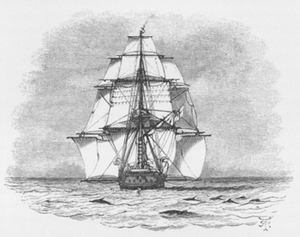Preparation and departure
 |
On August 24th 1831, John Stevens Henslow wrote a letter to Darwin with an unusual proposition. Captain Robert FitzRoy of the HMS Beagle wanted a person with an interest in science to keep him company on the forthcoming journey. Henslow recommended Darwin, who was thrilled at the possibility. At first Darwin’s father did not allow Darwin to leave, but was persuaded once Darwin’s uncle, Josiah Wedgwood II convinced him that it would be a respectable and good thing for the future parson to accept the invitation.
Darwin and FitzRoy got along splendidly and the preparations for the voyage began. On December 27th 1831 the HMS beagle set sail from Plymouth. For Darwin, the adventure began with severe seasickness. Everyone believed he would soon adjust to life on the sea, but they were wrong. Luckily for Darwin, he spent most of the five year long voyage ashore.
The ship was not allowed to dock in Tenerife. The local authorities feared for the potential danger of contamination from the cholera epidemic in England. Darwin was disappointed. It had been a big dream to climb Teide, Tenerife’s extinguished volcano. The disappointment did however quickly disappear after a visit to the Cape Verde Islands, which to Darwin became an introduction to a world immensely different from his safe and familiar surroundings.
As a travel gift, Darwin was presented with the first volume of Charles Lyell’s recently published Principles of Geology. In the book, he learned how tiny changes over a very long period of time could lead to massive geological changes. The insight Darwin received from Lyell would make an impact on everything he experienced for the rest of the voyage.
Peter C. Kjærgaard









